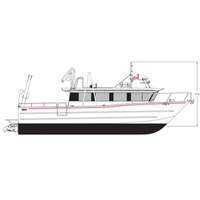
BRIX Marine Building Research Vessel for Long Island Sound Study
laboratory, allowing scientists to process data directly from water sampling and trawl fishing activities. The new lab will be twice the size of the one on the RV John Dempsey, enabling larger research teams to work together on important environmental studies.The vessel will be powered by two 750HP Scania DI13 Marine Diesel engines, providing enhanced power for efficiency and improved range. It will also have a fuel capacity of 2 x 250 gallons, allowing for extended research missions with minimal need for refueling.“Our LabCat hulls have built a reputation for performing like much larger vessels
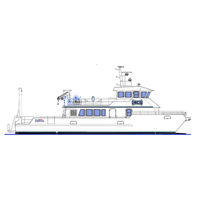
University of North Carolina Wilmington Orders Research Vessel from All American Marine
a hydrofoil-assisted hull, ensuring reduced drag, enhanced fuel efficiency and passenger comfort. This dynamic hull design is optimized for stability and performance in various sea conditions. The vessel is designed to comply with U.S. Coast Guard (USCG) Subchapter T standards.Equipped with twin Scania Di16-082M EPA Tier 3 engines, each producing 800 mhp at 2,100 rpm, the propeller-driven vessel will achieve a transit speed of 21 knots and a fuel-efficient survey operation speed of 1.5 knots. The large fuel capacity of 1,500 gallons ensures extended operational range and endurance.The vessel will
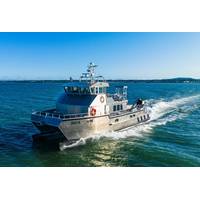
All American Marine Delivers Research Vessel for the University of Hawai’i at Mānoa
and with a fuel-efficient minimum survey speed of 3 knots. With a large fuel capacity of 1800 gallons, this design will support a science team of 8 on offshore multiday missions and 22 students/crew on shorter day excursions. The propulsion package includes 2x fixed pitch propellers, powered by twin Scania DI16, 082M, Tier 3 engines, rated at 800 mhp at 2100 RPM. Onboard the vessel, scientists and crew have comfortable live-aboard quarters, large state-of-the-art wet and dry lab spaces, as well as a range of the latest oceanographic equipment in which to conduct a variety of missions. The vessel was
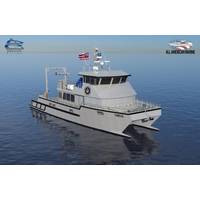
AAM to Build Research Vessel for the University of Hawaiʻi at Mānoa
22-24 knots and with a fuel-efficient minimum survey speed of 3 knots. With a large fuel capacity of 1,800 gallons, this design will support a science team of 8 on offshore missions and 22 students/crew on shorter day excursions. The propulsion package includes two fixed pitch propellers, powered by twin Scania DI16, 082M, Tier 3 engines, rated at 800 mhp at 2,100 RPM. On board the vessel, scientists and crew have comfortable live-aboard quarters, large state-of-the-art wet and dry lab spaces, as well as a range of the latest oceanographic equipment in which to conduct a variety of missions. The vessel
SISTAC: Brazil´s Homegrown Subsea Service Provider
a pair of dive platforms and two deck cranes. Inside the main deckhouse are functional areas such as toilets and showers, dive shop (housing compressor and decompression chamber) and ROV shop.Below decks are accommodations for the remaining 33 crew members, in a mix of two, three and four-berth cabins. 4 Scania D13 main engineers, each producing 410kW, power the vessel.The DP-2 capability ensures the vessel can hold station in the event of a failure in any single component of the system, enhancing both safety and reliability.Main ParticularsLength, o.a.: 42.5mLength, waterline: 38.5mBeam: 9.3mDraft (hull):
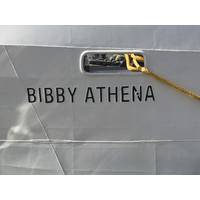
d’ROP Bibby’ Hydromap’s Custom-built ROV
; 12 knots Survey speed 6 knots Endurance 10 days Fuel Consumption, transit 2.5 cu.m./day Fuel Consumption, survey speed 1.2 cu.m./day Fuel Consumption, DP 1.8 cu.m./day Generators 2 x Scania DI13-074M Tank capacity, gas oil 24 cu. m. Tank capacity, fresh water 8 cu. m. Tank capacity, water maker 2 cu. m./day Crane Palfinger Max. lift 5450kg @ 4.2m Moonpool 2.05 x 2.3m A-Frame&nbs
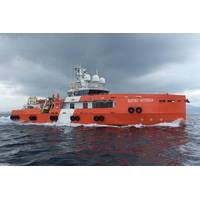
Incat-design DSV Delivered
, DP-2 monohull dive support vessel intended for service in Brazilian offshore waters has been delivered to Sistac Sistemas De Acesso S.A. The vessel was designed by Incat Crowther in collaboration with the vessel’s builder, SeaSafe Barcos Manufacturados S.A. in Angra dos Reis, Brazil. Four Scania DI13 main engines driving Hamilton HM 521 waterjets through ZF 665 gearboxes supplies propulsion power to the vessel. Diver safety and maneuverability were key drivers in the selection of waterjet propulsion, the designer said, adding that station-keeping and maneuverability are further enhanced
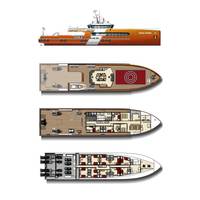
Incat Crowther Designs DSV Trio
, mess areas and two single-berth cabins for senior personnel and a designated officer cabin. A spacious wheelhouse is located upstairs, with forward and aft facing vessel control stations, ROV and dive control workstations. Overhead windows are fitted both fore and aft for high-angle visibility. Four Scania D13 main engines, each producing 410kW, will power the vessels. The vessels will have a service speed of 13 knots and a top speed of 15 knots. The DP-2 capability ensures the vessel can hold station in the event of a failure in any single component of the system, enhancing both safety and reliability
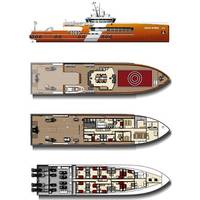
Incat Crowther Designs Dive Support Vessel Trio
stations, ROV and dive control workstations. Overhead windows are fitted both fore and aft for high-angle visibility. Below decks are accommodations for the remaining 33 crew members, in a mix of two-, three- and four-berth cabins. All accommodation cabins feature their own ensuite bathrooms. Four Scania D13 main engines, each producing 410kW, will power the vessels. The vessels will have a service speed of 13 knots and a top speed of 15 knots. The DP-2 capability ensures the vessel can hold station in the event of a failure in any single component of the system, enhancing both safety and reliability

 August 2025
August 2025





